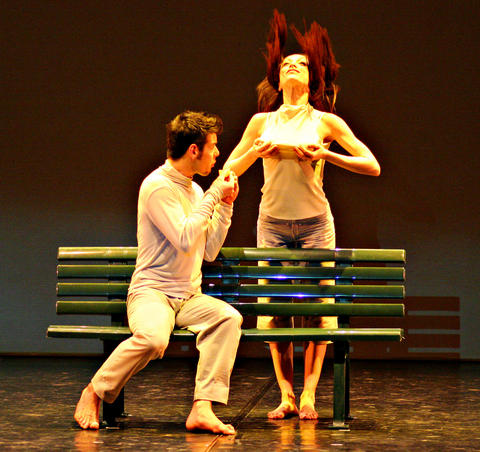Italian prima ballerina turned choreographer Francesca Selva is bringing her small self-named company to Taiwan next week for performances in Taipei and Changhua.
In her long and distinguished career as a dancer, Selva worked with some European greats, including choreographers Roland Petit and Boris Tonin Nikisch, and dancers Rudolph Nureyev, Mikahil Baryshnikov and Sylvie Guillem.
She began her ballet training in Italy at the National Dance Academy in Rome and at the Ballet School of the Teatro alla Scala in Milan before moving to France for more study before starting her career with Petit's Ballet de Marseille in the late 1970s. She eventually danced with companies all over Europe as well as the US and Mexico and began choreographing when she was a dancer with the Compagnia Balletto Europeo from 1986 to 1990.

Selva returned to Italy to work and live in 1992 and in 1995 she founded her company, along with the Centro Danza in Siena. The company made its debut in 1995 at the Spalato Summer Arts Festival and gained immediate notice. Selva has never looked back.
While Selva is unmistakably Italian, her years in France has left a distinctly Gallic flavor to her work. So it is fitting that the piece she is bringing to Taiwan, Les Bancs Publics or Public Benches, was created in 2005 to commemorate the centenary of the birth of French existentialist philosopher Jean-Paul Sartre.
For Public Benches, a work for three women, a man, a park bench and some oranges, Selva took her inspiration from some lines in Satre's first novel, Nausea:
"I was in the park just now. The roots of the chestnut tree were sunk in the ground just under my bench. I couldn't remember it was a root any more. The words had vanished and with them the significance of things ... the root, the park gates, the bench, the sparse grass, all that had vanished ... . All is free, this park, this city and myself."
Set to a score that ranges from French romantic composer Georges Bizet to French poet and cabaret singer Georges Brassens, the choreography gently flows from intense, lyrical moments to lighter, more ironic ones. The choreography is contemporary, but the grounding is pure classical ballet. The park bench is at once both a prop for and a spectator or witness to the dancers' exploration of life and love.
And - probably because Selva's European - there is a black and white video, this one produced by Arte-V Milan. It doesn't seem possible for any choreographer working in Europe these days to do a piece without including one or more video projection.
The company will perform twice at Taipei's Metropolitan Hall - on Wednesday and Thursday, and then at the Yuanlin Hall in Changhua on Saturday, July 21.

In the March 9 edition of the Taipei Times a piece by Ninon Godefroy ran with the headine “The quiet, gentle rhythm of Taiwan.” It started with the line “Taiwan is a small, humble place. There is no Eiffel Tower, no pyramids — no singular attraction that draws the world’s attention.” I laughed out loud at that. This was out of no disrespect for the author or the piece, which made some interesting analogies and good points about how both Din Tai Fung’s and Taiwan Semiconductor Manufacturing Co’s (TSMC, 台積電) meticulous attention to detail and quality are not quite up to

April 21 to April 27 Hsieh Er’s (謝娥) political fortunes were rising fast after she got out of jail and joined the Chinese Nationalist Party (KMT) in December 1945. Not only did she hold key positions in various committees, she was elected the only woman on the Taipei City Council and headed to Nanjing in 1946 as the sole Taiwanese female representative to the National Constituent Assembly. With the support of first lady Soong May-ling (宋美齡), she started the Taipei Women’s Association and Taiwan Provincial Women’s Association, where she

It is one of the more remarkable facts of Taiwan history that it was never occupied or claimed by any of the numerous kingdoms of southern China — Han or otherwise — that lay just across the water from it. None of their brilliant ministers ever discovered that Taiwan was a “core interest” of the state whose annexation was “inevitable.” As Paul Kua notes in an excellent monograph laying out how the Portuguese gave Taiwan the name “Formosa,” the first Europeans to express an interest in occupying Taiwan were the Spanish. Tonio Andrade in his seminal work, How Taiwan Became Chinese,

Mongolian influencer Anudari Daarya looks effortlessly glamorous and carefree in her social media posts — but the classically trained pianist’s road to acceptance as a transgender artist has been anything but easy. She is one of a growing number of Mongolian LGBTQ youth challenging stereotypes and fighting for acceptance through media representation in the socially conservative country. LGBTQ Mongolians often hide their identities from their employers and colleagues for fear of discrimination, with a survey by the non-profit LGBT Centre Mongolia showing that only 20 percent of people felt comfortable coming out at work. Daarya, 25, said she has faced discrimination since she